Search
Search for "click":
(Click here to search this entire website for "click" with Google.)
 |

|
|
Air quality 2 click carries the iAQ-Core Indoor Air Quality sensor that measures VOC levels and provides CO2 equivalent and TVOC equivalent predictions. The click is designed to run on either 3.3V or 5V power supply. It communicates with the target MCU over I2C. |
|
|
|
 |
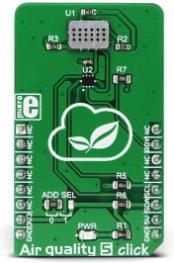
|
|
Air quality 5 click is a triple MOS sensor on a single Click board™, which can detect gas pollution for a number of different gases. The onboard sensor is specially designed to detect the pollution from automobile exhausts, as well as the gas pollution from the industrial or agricultural industry. This Click board™ uses the MiCS-6814, a compact MOS sensor with three fully independent sensing elements in one package: RED sensor, OX sensor, and NH3 sensor. Each of these sensors reacts with the specific type of gases, providing gas readings that including carbon monoxide (CO), nitrogen dioxide (NO2), ethanol (C2H5OH), hydrogen (H2), ammonia (NH3), methane (CH4), propane (C3H8), and isobutane (C4H10). Measurement conversion is handled by the onboard 12bit ADC converter and it is available via the I2C interface. |
|
|
|
 |

|
|
ATA6563 click carries the ATA6563 high-speed CAN transceiver. The click is designed to run on a 5V power supply. Use the VIO SEL jumper for selecting the 3.3V or 5V logic level.
It communicates with the target microcontroller over UART interface, with additional functionality provided by the AN pin on the mikroBUS™ line. |
|
|
|
 |
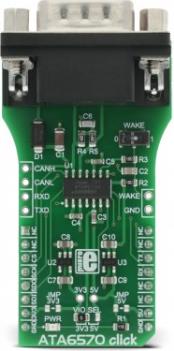
|
|
ATA6570 click is an automotive diagnostic tool that allows CAN bus interfacing, in a series of click boards™ aimed towards automotive diagnostics. The click carries the ATA6570, a high-speed CAN transceiver that interfaces a Controller Area Network (CAN) protocol controller and the physical two-wire CAN bus. This IC has some unique features that make it a perfect choice for any embedded CAN application.
It supports both CAN and CAN FD protocol types, partial networking, local and remote wake up, an SPI interface for internal registers configuration, and it features six operating modes as well as the undervoltage and overtemperature protection. The power consumption is taken to a minimum, as the ATA6570 can power down the entire system until a valid wake-up frame is received - even on a busy CAN bus. The car battery supply pin and the CAN bus pins are protected from various interferences and voltage instabilities, typically observed in automotive systems. ATA6570 click provides you with a robust and reliable CAN bus interface. |
|
|
|
 |

|
|
CC3000 click is an add-on board in the mikroBUS form factor. It features the CC3000MOD WiFi module, as well as a ceramic antenna, for adding WiFi functionality without requiring too much Wi-Fi or RF expertise. The Texas Instruments CC3000MOD integrates the IPv4 TCP/IP stack with built-in network protocols (ARP, ICMP, DHCP client and DNS client). This simplifies connection to local networks and/or the Internet, while minimizing software requirements for the target board MCU. The CC3000 click enables OFDM rates from 1 to 54 Mbps in the 2.4-GHz ISM band. CC3000 also has integrated EEPROM memory. The ceramic antenna has a maximum range of about 70 meters in open space. The board is designed to operate on a 3.3V supply only, and communicates via a SPI interface. |
|
|
|
 |

|
|
If you are building an IoT device that connects to the internet through WiFi, your two biggest concerns are power consumption and security – both major strengths of the module onboard CC3100 click.
This WiFi click board carries the successor of the highly popular CC3000 module from Texas Instruments. Its claim to fame was that it simplified WiFi for embedded developers by integrating multiple Internet Protocols and a Wifi driver with a simple API.
CC3100 inherits all these benefits, and on top of that, adds an updated protocol stack (support for 802.11n) and cutting edge security features (TSL encryption, hardware crypto-engine and more). |
|
|
|
 |
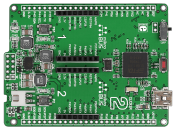
|
|
clicker 2 is a battery-powered click board with two mikroBUS sockets on board allowing you to take advantage of the huge potential of click boards. This clicker 2 is powered by FT900, a 32-bit FT32 core MCU that operates at 100MHz, has 256kB of flash, 64kB on-chip data memory, and 256kB shadow program memory. The shadow program memory is where the code is executed from, enabling the MCU to work with zero wait states at 100MHz — making it faster than many MCUs with higher clock rates. The onboard LTC 3586-1 IC will provide 3.3V or 5V to the clicks. It turns the USB port into a battery charger. For convenience, clicker 2 for FT900 features a reset button and an ON/OFF switch (you can also connect an external ON/OFF switch). clicker 2 has the same pocket-size form factor and the same pair of 1x26 connection pads as mikromedia boards. This makes it compatible with mikromedia shields letting you expand your device any way you want. |
|
|
|
 |
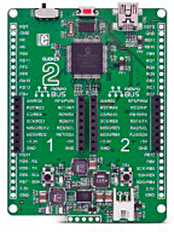
|
|
clicker 2 for PIC24 is a compact development kit with two mikroBUS sockets for click board connectivity. It carries the PIC24FJ1024GB610, a 16-bit microcontroller, that features large dual partition flash with live update capability.With a built-in USB-HID bootloader the clicker 2 for PIC24 is easy to program. |
|
|
|
 |
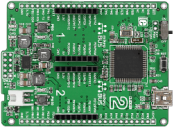
|
|
clicker 2 for STM32 is a compact dev. kit with two mikroBUS sockets for click board connectivity. You can use it to quickly build your own gadgets with unique functionalities and features. It carries STM32F407VGT6, a 32-bit ARM Cortex-M4 microcontroller, with a built-in USB-HID bootloader that makes it easy to program. A JTAG connector is also available. Whichever way you upload the firmware, you can turn clicker2 into a standalone gadget because it has a li-po battery connector. The battery (sold separately) can be charged via USB thanks to the LTC3586-2 power management IC that can also provide an independent power supply to the MCU's RTC. Additional features include 2x26 connection pads on the sides of the board, and some buttons, switches and LEDs. |
|
|
|
 |
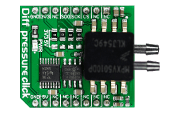
|
|
Diff pressure click is a mikroBUS add-on board carrying an NXP MPXV5010DP signal conditioned, temperature compensated and calibrated pressure sensor with two axial ports to accommodate industrial grade tubing. It is designed for comparing two pressure measurements.
The two ports are designated as Pressure side (P1) and Vacuum side (P2). The sensor is designed to operate with a positive differential pressure where P1 > P2. The measurement range is from 0 to 10 kPa. In the temperature range between 0º and 85ºC, the sensor has a maximum error rate of 5.0%.
MPXV5010DP IC has an analog output. The signal passes through the onboard 22-bit ADC before being outputted through the mikroBUS SPI interface (CS, SCK, MISO).
Diff pressure click is designed to use either a 3.3V or a 5V power supply |
|
|
|
 |
|
<< First
< Previous
Next >
|
|

